 |
Smith
in the Netherlands: A Transatlantic Connection
Peter Rose, Sophia
Smith Professor Emeritus of Sociology and Antrhopology,
was the first chair of the International Advisory Committee
of University College Utrecht and the Roosevelt Academy,
Middelburg, both in The Netherlands, and both based on
the Smith model.
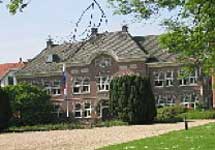
College Hall, University College
Utrecht |
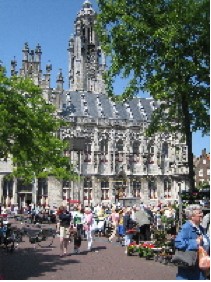
The Stadhuis, the main building
of the Roosevelt Academy |
If one believes that imitation
is the best form of flattery, then members of the Smith College
community should feel very flattered. Over the last 15 years
two new English-language international honors colleges—University
College Utrecht (UCU) and the Roosevelt Academy (RA)—have
been established and are flourishing in the Netherlands.
Smith served as the catalyst and model for both.
The two colleges are a part of the venerable old University
of Utrecht, founded in 1636.
University
College Utrecht is located half way and an easy bike ride
between the center of the medieval city where some of the
original university buildings are located and the very
modern suburban campus in an area known as the Uithof.
Created on the site of a former army post, like most American
colleges, UCU is self-contained, integrating academic,
residential buildings and facilities for dining and student
services around a series of quads. Its 400 Dutch and 250
foreign students all live on campus, though some take courses,
mainly in lab sciences, in the Uithof area. There is a
core faculty, mainly those who chair one of the four main
units—Humanities, Sciences, Social Sciences,
and one that offers orientation courses such as Dutch history
and language for international students—and a number
of tutors. Other instructors come over from the main sectors
of the university or from other Dutch or foreign universities.
UCU was the first institution of higher learning in the
Netherlands and one of the first on the European continent
to offer a Bachelor of Arts degree.
Instead of the pillared
design that characterizes almost all European universities,
in which graduates of classical high schools go immediately
into narrowly specialized disciplines such as literature,
law, economics, or medicine, from the start, the planners
of UCU favored the more American pyramidal system where
students take a variety of courses across the curriculum
in their first year and, over the next two, narrow the
focus to concentrate on a “major.” The scheme
proved to be a prototype of what is now widely known as the
Bologna Protocol, an agreement by most European countries
to move in the direction of replacing the vast array of degree
programs with a BA/MA sequence. At UCU the designers of the
program opted for a three-year BA, similar to what is found
in the United Kingdom.
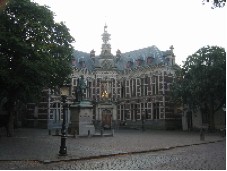
Main Building, Utrecht University |
In almost all other respects,
not only is the UCU a near-replication of the American liberal
arts system but also its academic structure and curriculum,
including original course designs and much of their content,
which were Smith-based. This was no accident.
In 1980, a young Dutch
sociologist from the University of Tilberg, Hans Adriaansens,
spent a year at Smith as a fellow of the American Council
of Learned Societies. He came to carry out research on
one American social institution especially intriguing to
him, the voluntary organization, and ended by studying
two. He did extensive interviewing of key
figures and observed the activities of many of Northampton’s
privately funded community services staffed by both professionals
and volunteers. Such organizations were hardly known
in Europe. He also became increasingly captivated by something
equally foreign to him, the American liberal arts college.
In his months spent on the Smith campus (and in almost daily
conversations with me and other denizens of Wright Hall,
as well as other colleagues), Hans started on a new path,
infused, as if by a kind of intellectual osmosis, with the
spirit and style of our college.
Not long after returning to The Netherlands, Hans moved to
Utrecht University and soon became the Dean of Social Sciences
and a member of the National Science Council, a prestigious
group of 10 scientists charged with investigating various
aspects of Dutch society. At the Council, he was given two
key portfolios: one focused on a reconsideration of the social
welfare system, the other looking into the state of tertiary
education. His background and experiences in Northampton
and the Hague led him to propose that his university experiment
with the sort of program he had come to appreciate so much
during his year at Smith. Despite considerable skepticism
in many quarters, he was given the green light to go ahead.
He then sought and received permission to acquire the recently
decommissioned army base with its 19th-Century solid-brick,
four-story barracks surrounding a parade ground in a choice
part of the city, raised millions of gulden (and, later euros)
mostly from Dutch government and regional sources, and, with
a board of academic advisers, including several from the
United States and the United Kingdom, built his new college.
The main building soon
became known, in good Smith tradition, as College Hall.
(I had suggested calling it “Machiavelli”).
The army barracks, some having been turned into classrooms,
were given loftier names like Locke and Pascal and Fermi;
the mess hall became the dining complex, and several halls
of residence were added. Students started arriving before
the construction was completed and before the paint was dry.
They had the feeling that they were pioneers. And they were.
The UCU exceeded even
Hans’—and my—wildest
expectations. Within a few years it gained a reputation as
a premier institution of higher learning in the Netherlands,
garnering more prizes per capita than any other, and placing
its graduates in master’s and doctoral programs throughout
the continent, in the U.K. and in the U.S., too.
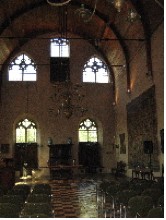
Inside the main hall of
the Stadhuis, Roosevelt Academy |
With so much accomplished, it was time to move on.
Unlike the center of the
country, where there are many great universities including
Utrecht and Leiden and Delft and the Universiteit van Amsterdam,
the southern province of Zeeland never had one. Hans Adriaansens,
now a highly regarded academic innovator, had a new idea:
to build a liberal arts college as the core of a new university.
He decided to do this in his—and the Roosevelt family’s—hometown
of Middelburg in the southern province of Zeeland.
Three years ago, the Roosevelt
Academy, the second Dutch liberal arts honors college linked
to Utrecht University opened its doors.
Instead of having an enclosed quadrangle, the campus of
the RA is the city of Middelburg, a city known for its unique
15th-Century Flemish-style Stadhuis, the former city hall.
That stately building on one side of a town square and marketplace
is now the administrative hub of the new college and locale
of one of the handsomest lecture halls in the country.
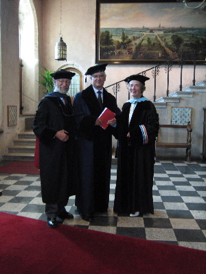
Left to right: Peter Rose,
Hans Adriaansens, and Hedy Rose, at Roosevelt Academy,
2005 |
Nearby buildings were taken over to provide classrooms and
halls of residence. Today, like its sister institution, UCU,
the RA attracts students from all over the Netherlands and
many other countries in Europe as well as from Africa, Asia
and North America.
The RA has gotten off to a flying start. Indeed, not to
be outdone by its older sister, UCU, or any other place,
a student-satisfaction survey of all Higher Education Institutions
in the Netherlands, just conducted by the influential Elsevier magazine,
put the Roosevelt Academy at the top. Researchers asked students
about the teaching quality, personal tutor system, the facilities
and campus life. In its second year of operation, the Roosevelt
Academy was awarded an 8.0—the highest grade in the
survey.
Those of us back in Northampton, hardly immune to the ratings
of our local institutions, can take considerable pride in
the accomplishments of our putative offspring.
Rose, recipient of the Medal of the Universiteit
van Amsterdam in 1994, spoke at the first commencement
of UCU. His Dutch
wife, Hedy Rose, former Director of Education Studies at
Wesleyan University, spoke at the convocation at RA in
2005.
|
 |























